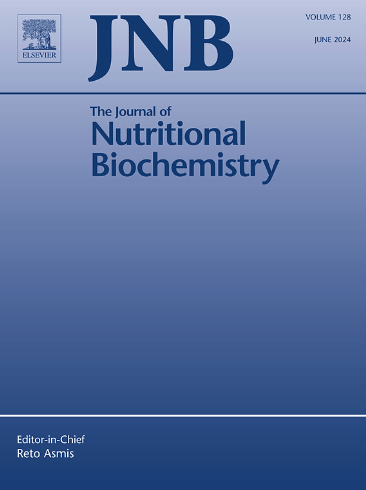Associations between flavonoids intake and sleep disorders: A survey-weighted cross-section study from NHANES
IF 4.8
2区 医学
Q1 BIOCHEMISTRY & MOLECULAR BIOLOGY
引用次数: 0
Abstract
This study aimed to evaluate the associations between flavonoid intake and sleep disorders. A cross-sectional study was conducted using data from the National Health and Nutrition Examination Survey (2007–2010, 2017–2018). Intake data for 29 flavonoids were derived from the average of two 24-hour dietary recall interviews. Sleep disorders and sleep duration were the outcome measures. Dummy variables were used to account for missing covariate values. Survey-weighted generalized linear models and survey-weighted restricted cubic splines were applied to explore the associations between flavonoid intake and sleep disorders/sleep duration. Sensitivity and stratified analyses were performed to verify the robustness of results and examine potential subgroup differences. A total of 10,162 participants were included. After adjusting for covariates, isorhamnetin intake was inversely associated with sleep disorders. The odds ratios (OR) for sleep disorder were 0.944 (95% CI: 0.893–0.999) for continuous isorhamnetin intake and 0.754 (95% CI: 0.651–0.874; Ptrend<.001) for the highest tertile. Luteolin intake, both continuous and in tertiles, was also significantly inversely associated with sleep disorders (continuous OR = 0.903, 95% CI: 0.822–0.991; tertiles OR = 0.851, 95% CI: 0.732–0.989; Ptrend = .031). Isorhamnetin intake, categorized by tertiles, was positively correlated with sleep duration (β = 0.125, 95% CI: 0.042–0.208; Ptrend = .004), with a nonlinear relationship identified (Pnon-linear = .0001). Sensitivity analysis confirmed the robustness of the results, and stratified analysis showed that luteolin's effect varied across different body mass index levels, while isorhamnetin's effect differed by age, gender, and race. Isorhamnetin and luteolin exhibit a significant negative correlation with sleep disorders. Isorhamnetin is linked to an increase in sleep duration. Additionally, both isorhamnetin and eriodictyol demonstrate a notable nonlinear relationship with sleep duration.
类黄酮摄入与睡眠障碍之间的关系:一项来自NHANES的调查加权横断面研究。
目的:探讨类黄酮摄入与睡眠障碍的关系。方法:采用全国健康与营养调查(2007-2010年,2017-2018年)的数据进行横断面研究。29类黄酮类化合物的摄入数据来自平均两次24小时的饮食回忆访谈。睡眠障碍和睡眠持续时间是结果测量指标。使用虚拟变量来解释缺失的协变量值。应用调查加权广义线性模型和调查加权限制三次样条来探讨类黄酮摄入量与睡眠障碍/睡眠持续时间之间的关系。进行敏感性和分层分析以验证结果的稳健性并检查潜在的亚组差异。结果:共纳入10162名受试者。调整协变量后,异鼠李素摄入量与睡眠障碍呈负相关。持续摄入异鼠李素的睡眠障碍的优势比(OR)为0.944 (95% CI: 0.893-0.999),而持续摄入异鼠李素的睡眠障碍的优势比(OR)为0.754 (95% CI: 0.651-0.874, Ptrendtrend=0.031)。异鼠李素摄入量与睡眠时间呈正相关(β=0.125, 95% CI: 0.042-0.208, Ptrend=0.004),并存在非线性关系(p非线性=0.0001)。敏感性分析证实了结果的稳健性,分层分析显示木犀草素的效果在不同的体重指数水平上存在差异,而异鼠李素的效果因年龄、性别和种族而异。结论:异鼠李素、木犀草素与睡眠障碍呈显著负相关。异鼠李素与增加睡眠时间有关。此外,异鼠李素和周期醇都与睡眠时间呈显著的非线性关系。
本文章由计算机程序翻译,如有差异,请以英文原文为准。
求助全文
约1分钟内获得全文
求助全文
来源期刊

Journal of Nutritional Biochemistry
医学-生化与分子生物学
CiteScore
9.50
自引率
3.60%
发文量
237
审稿时长
68 days
期刊介绍:
Devoted to advancements in nutritional sciences, The Journal of Nutritional Biochemistry presents experimental nutrition research as it relates to: biochemistry, molecular biology, toxicology, or physiology.
Rigorous reviews by an international editorial board of distinguished scientists ensure publication of the most current and key research being conducted in nutrition at the cellular, animal and human level. In addition to its monthly features of critical reviews and research articles, The Journal of Nutritional Biochemistry also periodically publishes emerging issues, experimental methods, and other types of articles.
 求助内容:
求助内容: 应助结果提醒方式:
应助结果提醒方式:


